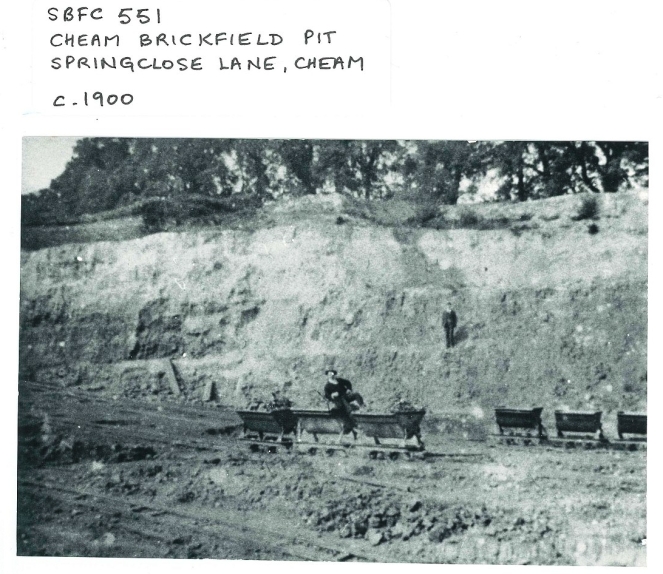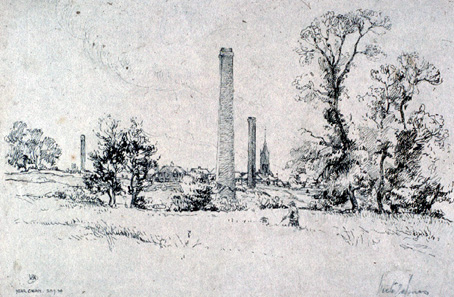
August object of the month has been written by one of our student volunteers for Sutton Heritage (Honeywood Museum & Whitehall Historic House) Lucy!
For this objects of the month we have a family run business of Cheam bricks and some interesting stories surrounding the members of the Waghorn family which includes a court case with the wife of William Richard Waghorn (founder of the Waghorn pottery).
Pottery was produced locally throughout the medieval period. There were kilns in Cheam, Kingston and Ewell. Remains of local pots and jugs have been found in excavations in the City of London and Essex and in 2009 a hoard of medieval coins was found in Thurrock, Essex in the remains of a Cheam drinking jug. The local industry declined from the Tudor period, but the clay continued to provide an income- being used for bricks and tiles.
Before 1800 a new pottery was opened in Nonsuch Park, which was founded by William Richard Waghorn (WRW) and his son. Waghorn specialised in producing ‘Italian tiling’ which was used for; roof tiles, ridge tiles, fire bricks and paving including ornamental pots and pipes. Waghorn then later on went to open a second pottery in Cheam. Work continued in the pottery until the retirement of Mr Waghorn in 1851 and then the business was transferred to Mr Baker until 1868. After this period of time the pottery was then again transferred to Mr. Cowley and Mr. Aston until the business finally closed in 1869.
In Cloudesley S Willis’ book, ‘A Short History of Ewell and Nonsuch’ (1931), he recalled the products made by the pottery; “The turnpike gate stood on the site of Woodgate. At the top of the hill was W R Waghorn’s pottery, where he made garden vases and ornamental tiling as well as the best fire bricks.” Later Cloudesley S Willis documented in his book that Ewell produced dark and bright red rubbing bricks and soft bricks which were used to create fine cut and carved brickwork. This published book demonstrates that Waghorn’s pottery was admired for its craftsmanship and is still being credited years after the closure of the business.
The Nonsuch pottery in 1851 was taken on by Mr Swallow who had previously worked for Waghorn and Swallow’s partner Stone. Swallow had been Waghorn’s foreman meaning the relationship between the two was strong and meant they could work together effectively. Stone and Swallow bought the businesses from William Richard Waghorn for £1000, 3 months before WRW died.

With the purchase of the businesses came; Messuage cottage and stable, brickground of 9 acres adjoining Ewell and Cuddington, Meadow and pastures, 3 acres adjoining brickground, right od access to nearby sandpit for digging sand for use in brickyard together with all buildings associated with the brickworks (as seen in the photograph) . In 1850 William Francis Gamnul Farmer was granted 21 year lease of brickfield. A stable lay between 2 cottages and the brickground adjoined. WRW had lately owned the sandpits, but after they purchase they were now in possession of Farmer.

In 1792, Richard Waghorn died and his widow Jane announced her intention to continue her husband’s business, as quoted in the issue of the General Evening Post (19th April 1792); “… And notice is also herby given, that Mrs Waghorn, the widow of her said late husband, intends to carry on her late husband’s business, for the benefit of herself and her numerous family, and earnestly hopes for the continuance of her late husband’s customers.”
Widow Jane and her son James Waghorn were granted the right to brickgrounds by Jane Whateley widow, land at Nonsuch. However, after Jane’s court case in 1793 (more of that story later!) John Stone (the son of George Stone) took over the business from Jane Waghorn. Furthermore, following the Swallow’s death (4th June 1866 aged 66 and his son’s death Matthew died 23rd June 1866) Stone continued to work alone and the works were known as ‘Nonsuch Pottery’ or ‘Stone’s Ewell and Epsom Potteries’. In 1875 widow of Swallow junior and her son (another Matthew) sold their share of the business to Stone which compromised 5 wooden cottages and a brick kiln. Stone then died aged 62 in 1878. The business was then passed to Ellen Jessy Keen (nee Stone), William John Stone and Frederick Steward Stone all of Ewell. Last brickwork closed in the mid 1930s.
Now it’s time for Jane’s court case!
Jane Waghorn was born 1739 and died in 1830 aged 91 and was buried at St. Dunstan’s on 24th August 1830. The court case took place in 1793.
Already being a widow, Jane was accused of defamation by Martha Pritchard. (Sourced from Lambeth Palace Archives) The case was titled ‘Jane Waghorn, widow of Cheam, vs Martha Pritchard, spinster of Epsom’. Martha filed for the case on 21st January 1793 (during the reign of King George III) and the case took place on 28th January same year, even though Jane was handed the court papers on 8th December 1792.
The citation reads;
“William Wynne, Knight, Doctor of Laws, Dean or Commissary of the Deaneries of the Arches London Shoreham and Croydon the Peculiar and immediate jurisdiction of the Cathedral and Metropolitical Church of Christ Canterbury lawfully constituted. To all and singular clerks and literate persons whomsoever and wheresoever in and throughout our whole peculiar jurisdiction aforesaid and especially to George Marshall Beadle of our said Court greeting. We do hereby authorize impower and strictly enjoin and command ye jointly and severally peremptorily to cite or cause to be cited Jane Waghorn of the parish of Cheam in the county of Surry and our peculiar jurisdiction aforesaid widow personally to appear before us our surrogate or some other competent judge in this behalf in the vestry room of the parish church of Saint Mary le Bow London within our peculiar jurisdiction of the Deaneries of the Arches London Shoreham and Croydon and place of jurisdiction there on the third day after she shall have been served with this citation if it be a court day otherwise on the court day then next following at the usual and accustomed hours of hearing causes and doing justice there, then and there to answer to Martha Pritchard of the parish of Ebbisham otherwise Epsom in the said County of Surry spinster in a certain cause of defamation and further to do an receive as unto law and justice shall appertain under pain of the law and contempt thereof at the promotion of the said Martha Pritchard and what shall do or cause to be done in the premises ye shall duly certify us, our surrogate or some other competent judge in this behalf together with these presents dated at London the twenty third day of November in the year o four Lord one thousand seven hundred and ninety two.
Signed Bristoll for Crickett… Martha Pritchard with having committed the foul crimes of adultery, fornication or incontinency, and speaking to or of and meaning and intending the said Martha Pritchard to party agent in this cause sayed affirmed and published several times, at least once, these or the like words (to wit) You, thou, or she, are, art, was or is a whore with many other scandalous and defamatory words and the party proponent doth alledge and propound everything in this article… That by reason of speaking the said defamatory words the good name fame and reputation of the said Martha Pritchard is very much hurt and injured amongst her neighbours friends acquaintance and others and this was and is true public and notorious and the party propound doth alledge…”
It was then agreed that Jane would have to pay one pound four shillings and two pence and would have to give penance, on Sunday 10th February 1793, in front of Sir William Wynne Knight after Divine Service and Sermon ended, come into the Vestry Room of the parish church of Cheam in the presence of Martha and five or six of her friends as witnesses. The penance was as follows;
“Whereas I Jane Waghorn have uttered and spoken certain scandalous and [approbrious] words of and against Martha Pritchard of the parish of Ebbisham otherwise Epsom in this County, to the great offence of Almighty God, the scandal of my Christian Religion and the injury and reproach of her Credit and Deputation by calling her Whore I do therefore before God and you humbly confess and acknowledge such offence, am heartily sorry for the same, and do ask her forgiveness; and pormice hereafter never to offend her in the like manner God assisting me.”
You can see Septembers Object of the Month and all of the objects discussed here in their accompanying display currently on at Cheam Library (Church Rd, Sutton, SM3 8QH) during regular library opening times.
